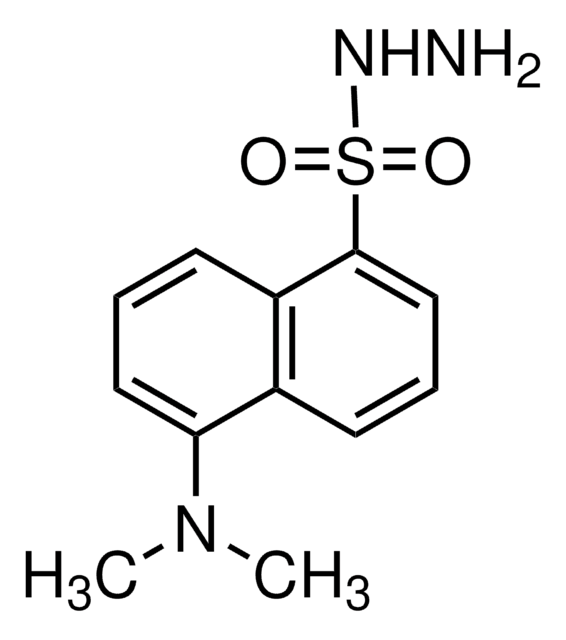Products may be shipped at a different temperature than the recommended long-term storage temperature. If the product quality is sensitive to short-term exposure to conditions other than the recommended long-term storage, it will be shipped on wet or dry-ice. If the product quality is NOT affected by short-term exposure to conditions other than the recommended long-term storage, it will be shipped at ambient temperature. As shipping routes are configured for minimum transit times, shipping at ambient temperature helps control shipping costs for our customers. For more information, please refer to the Storage and Transport Conditions document: https://www.sigmaaldrich.com/deepweb/assets/sigmaaldrich/marketing/global/documents/316/622/storage-transport-conditions-mk.pdf
40718
Diethyl pyrocarbonate
96% (NT)
Synonym(s):
DEP, DEPC, Diethyl dicarbonate, Diethyl oxydiformate, Ethoxyformic acid anhydride
Select a Size
Select a Size
About This Item
Recommended Products
assay
96% (NT)
form
liquid
color
APHA: ≤20
refractive index
n20/D 1.398 (lit.)
n20/D 1.398
bp
93-94 °C/18 mmHg (lit.)
solubility
95% ethanol: 4.5 g/10 mL, clear, colorless
density
1.121 g/mL at 20 °C
1.101 g/mL at 25 °C (lit.)
functional group
carbonate
shipped in
wet ice
storage temp.
2-8°C
SMILES string
CCOC(=O)OC(=O)OCC
InChI
1S/C6H10O5/c1-3-9-5(7)11-6(8)10-4-2/h3-4H2,1-2H3
InChI key
FFYPMLJYZAEMQB-UHFFFAOYSA-N
Looking for similar products? Visit Product Comparison Guide
Related Categories
General description
Application
- For the modification of histidyl residues in proteins.[2]
- As a nuclease inhibitor, for the extraction of undegraded nucleic acids from etiolated and green plant tissues.[3]
- For the modification of linear and supercoiled plasmid DNAs.[4]
- As a chemical probe to investigate the secondary structure in negatively supercoiled DNA.[4]
- For cabethoxylation of histidine residues of actin.[5]
Biochem/physiol Actions
signalword
Warning
hcodes
Hazard Classifications
Acute Tox. 4 Oral
Storage Class
10 - Combustible liquids
wgk_germany
WGK 3
flash_point_f
156.2 °F - closed cup
flash_point_c
69 °C - closed cup
ppe
Eyeshields, Faceshields, Gloves, type ABEK (EN14387) respirator filter
Choose from one of the most recent versions:
Already Own This Product?
Find documentation for the products that you have recently purchased in the Document Library.
Customers Also Viewed
-
How is shipping temperature determined? And how is it related to the product storage temperature?
1 answer-
Helpful?
-
-
How can I determine the shelf life / expiration / retest date of this product?
1 answer-
If this product has an expiration or retest date, it will be shown on the Certificate of Analysis (COA, CofA). If there is no retest or expiration date listed on the product's COA, we do not have suitable stability data to determine a shelf life. For these products, the only date on the COA will be the release date; a retest, expiration, or use-by-date will not be displayed.
For all products, we recommend handling per defined conditions as printed in our product literature and website product descriptions. We recommend that products should be routinely inspected by customers to ensure they perform as expected.
For products without retest or expiration dates, our standard warranty of 1 year from the date of shipment is applicable.
For more information, please refer to the Product Dating Information document: https://www.sigmaaldrich.com/deepweb/assets/sigmaaldrich/marketing/global/documents/449/386/product-dating-information-mk.pdfHelpful?
-
-
What is the solubility and solution stability of Diethyl pyrocarbonate, DEPC?
1 answer-
DEPC can be solubilized in 95% ethanol, e.g. 1.6 mL in 4 mL ethanol gives a clear, colorless solution. DEPC is soluble in alcohols, esters, ketones and other hydrocarbons, but has limited solubility in water (~0.1%). 6 DEPC hydrolyzes in aqueous solution, to form ethanol and carbon dioxide (CO2). Typically a 0.1% DEPC solution (1 mL of DEPC diluted in water to 1 L) is used to inactivate RNase. The DEPC will not immediately dissolve, as evidenced by the appearance of globules. The mixture should be stirred until the globules disappear. DEPC is sensitive to pH. In phosphate buffer at 25 °C, its half-life is 4 minutes at pH 6, and 9 minutes at pH 7. Hydrolysis is accelerated by Tris buffer,7 where at 25 °C, the half-life of DEPC was reported to be 1.25 minutes at pH 7.5, and 0.37 minutes at pH 8.2. DEPC will decompose in solution when autoclaved. For 0.1% DEPC solutions, autoclaving for 15 minutes per liter should be sufficient.
DEPC is very sensitive to moisture. As such, DEPC is packaged under argon to help reduce exposure to moisture. If DEPC is exposed to even traces of moisture, some hydrolysis occurs. The resulting CO2 is more soluble in DEPC solutions at 2–8 °C than at room temperature. As the product is brought to room temperature before opening, the DEPC can become supersaturated with respect to any dissolved gas. After opening the bottle for the first time and each time thereafter, layer nitrogen or argon gas over the DEPC and store the closed bottle at 2–8 °C for optimal stability. It may be helpful to store the bottle inside a sealed plastic bag with desiccant, but with the bottle cap slightly loose. If the bag inflates at all, this indicates some degree of decomposition with possible pressure build-up. Once opened, the bottle should not be kept for more than 9 months. DEPC decomposes at 155 °C. DEPC is also sensitive to ammonia, which causes decomposition to urethane.Helpful?
-
Active Filters
Our team of scientists has experience in all areas of research including Life Science, Material Science, Chemical Synthesis, Chromatography, Analytical and many others.
Contact Technical Service







